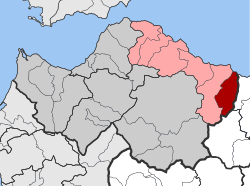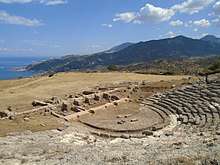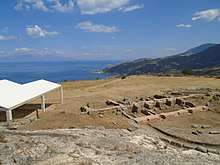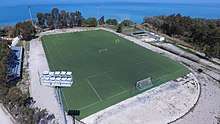Aigeira
Aigeira (Greek: Αιγείρα) (IPA: [eˈʝira], Ancient Greek: Αἰγείρα or Αἴγείρα, Latin: Aegeira) is a town and a former municipality in northeastern Achaea, West Greece, Greece. Since the 2011 local government reform it is part of the municipality Aigialeia, of which it is a municipal unit.[2] The municipal unit has an area of 103.646 km2.[3] The municipal unit stretches from the Gulf of Corinth, where the town Aigeira is located, to the mountains in the south. The town Aigeira is 26 km (16 mi) southeast of Aigio, 55 km (34 mi) northwest of Corinth and 55 km (34 mi) east of Patras. The Greek National Road 8A (E65 Corinth - Patras) and the railway Corinth - Patras run through the town. In a distance of 6 Km from modern Aigeira there is the archaeological site of Ancient Aigeira and the Mycenean Acropolis.
Aigeira Αιγείρα | |
|---|---|
 Aigeira Location within the regional unit  | |
| Coordinates: 38°9′N 22°21′E | |
| Country | Greece |
| Administrative region | West Greece |
| Regional unit | Achaea |
| Municipality | Aigialeia |
| Districts | 11 |
| • Municipal unit | 103.65 km2 (40.02 sq mi) |
| Elevation | 10 m (30 ft) |
| Population (2011)[1] | |
| • Municipal unit | 2,626 |
| • Municipal unit density | 25/km2 (66/sq mi) |
| Community | |
| • Population | 1,462 (2011) |
| Time zone | UTC+2 (EET) |
| • Summer (DST) | UTC+3 (EEST) |
| Postal code | 250 10 |
| Area code(s) | 26960 |
| Vehicle registration | ΑΧ |
| Website | www.aigeira.gr aigeira.org, [English] |
Subdivisions
The municipal unit Aigeira is subdivided into the following communities:
- Aigeira
- Aiges
- Ampelokipoi
- Chrysanthio
- Exochi
- Monastiri
- Oasi
- Perithori
- Seliana
- Sinevro
- Vella
Historical population
| Year | Community | Municipality |
|---|---|---|
| 1981 | 1,320 | - |
| 1991 | 1,696 | 4,211 |
| 2001 | 1,673 | 4,503 |
| 2011 | 1,462 | 2,626 |
History


The area was settled in the 3rd millennium BC. Aegeira was a member of the Achaean League, one of the 12 Achaean cities, situated between Aegae and Pellene. It is described by Polybius as opposite Mount Parnassus, situated upon hills strong and difficult of approach, seven stadia from the sea, and near a river.[4] This river was probably the Crius, which flowed into the sea, a little to the west of the town. According to the geographer Pausanias, the city consisted of two parts: a port on the Gulf of Corinth and the upper town, 12 stadia (2 km (1.2 mi)) from the port; the upper city was 72 stadia from the oracle of Heracles Buraicus.[5][6][7][8] Pausanias relates that Aegeira occupied the site of the Homeric Hyperesia (Ὑπερησίη), which is listed in the Catalogue of Ships in the Iliad.[5][9][10] and that it changed its name during the occupation of the country by the Ionians. According to Pausanias, in 688 BCE, Hyperesia was threatened by a hostile army from Sicyon. The locals defended their city by placing burning torches on their goats' (aiges in Greek) horns. As a result, the invaders left in fear while the Hyperesians renamed their town Αigeira to honor the goats.[5] He adds that the ancient name still continued in use. Hence we find that Icarus of Hyperesia was proclaimed victor in the 23rd Olympiad in 688 BC.;[11] Eusebius refers his name as Icarius.[12] Also, Cratinus of Aegeira wins the Olympic prize for boys' wrestling in 260 BC during the 130th Olympiad.[13] On the decay of the neighbouring town of Aegae its inhabitants were transferred to Aegeira.[7]
In the first year of the Social War, in 220 BCE, Aegeira was surprised by a party of Aetolians, who had set sail from the opposite town of Oeantheia in Locris, but were driven out by the Aegiratans after they had obtained possession of the place.[14] The most important of the public buildings of Aegeira was a temple of Zeus. It also contained a very ancient temple of Apollo, and temples of Artemis Agrotera, of Aphrodite Urania, who was worshipped in the town above all other divinities, and of the Syrian Goddess, all in the upper town.[15]
Archaeology
The Austrian Archaeological Institute made excavations in Aigeira in 1916. The team with Otto Walter found the head of the statue of Zeus, which according to Pausanias was a work by the Athenian sculptor Euclid.[5] Walter also found the left arm, the finger at the right hand later. In August 1972, after a break of 45 years, the excavations of the ancient Aigira started over. The excavations of the Austrian Archaeological Institute of Athens took place in four places, the Acropolis, the ancient theatre, the ruins of the temple of Zeus and the space between the theatre and the temple of Zeus. Ancient buildings and numerous shells were found in the Acropolis, dating from the Mycenaean period to the Roman times. Also, a part of the theatre was revealed with its terraces, which are carved in a sloping rock. Two large sections were opened in the theatre, in which ancient buildings appear. Near the theatre, an ancient building was revealed, on the right-hand side of which, along with its entire length, there are carved dips resembling animal troughs. Northwest of the theatre a furnace was revealed while vases were also collected, many of which date back to the geometric period. There were also sections of the willow with bright colouring, broken clay dishes, and shells. A water pipeline was found on the right side of the furnace. West of the theatre a mosaic of river gravel with various emblazonments was revealed. Finally, near the mosaic, an Ionian-style chapiter and a lot of structural material, which belonged to the temple of Zeus, were found.
The 1972 excavations led by Wilhelm Alzinger also excavated several naiskoi next to the theatre (naiskos (small temple)). The floor of one of them is decorated with a pebble mosaic representing an eagle with a serpent. Also, the Tycheio (sanctuary of Tyche) described by Pausanias was uncovered next to the theatre. Further to the north, the foundations of two small temples were explored by Anton Bammer. On the terrace north of the Acropolis, a presumably public building with banqueting rooms and bathing facilities was located and excavated by Georg Ladstätter.
Sport
The town is home to the Aigeira Municipal Stadium, which features an artificial turf pitch and a gravel running track.

Its major soccer team is A.O. Thyella Aigeiras. Since July 2018 the club merged with the local football team of the neighbour town of Akrata forming a new club under the name A.E. Aigeiras/Akratas.[16] Aigeira is also home to non-league amateur football club Panaigeiratikos.
See also
Gallery
- Theatre in Aigeira
References
- "Απογραφή Πληθυσμού - Κατοικιών 2011. ΜΟΝΙΜΟΣ Πληθυσμός" (in Greek). Hellenic Statistical Authority.
- Kallikratis law Greece Ministry of Interior (in Greek)
- "Population & housing census 2001 (incl. area and average elevation)" (PDF) (in Greek). National Statistical Service of Greece. Archived from the original (PDF) on 2015-09-21.
- Polybius. The Histories. 2.41, 4.57.
- Pausanias. Description of Greece. 7.26.1.
- Herodotus. Histories. 1.146.
- Strabo. Geographica. viii. p.386. Page numbers refer to those of Isaac Casaubon's edition.
- Pliny. Naturalis Historia. 4.6.
- Homer. Iliad. 2.573, 15.254.
- Strabo. Geographica. viii. p. 383. Page numbers refer to those of Isaac Casaubon's edition.
- Pausanias. Description of Greece. 4.15.1.
- "Eusebius: Chronicle (2) - translation". www.attalus.org.
- "Perseus Under Philologic: Paus.%206.3.5". perseus.uchicago.edu. Retrieved 8 March 2019.
- Polybius. The Histories. 4.57-58.
- Pausanias. Description of Greece. 7.26.1. et seq.
- Συγχωνεύονται Ακράτα και Θύελλα Αιγείρας!. Pelop.gr (in Greek).
![]()
External links
- Austrian Archaeological Institute, Research in Aigeira
- Österreichische Akademie der Wissenschaften The Mycenian settlement in Aigeira (in German)
- GTP - Ancient Aigeira
- GTP - Aigeira
- GTP - Municipal unit of Aigeira
- SC Panaigeiratikos